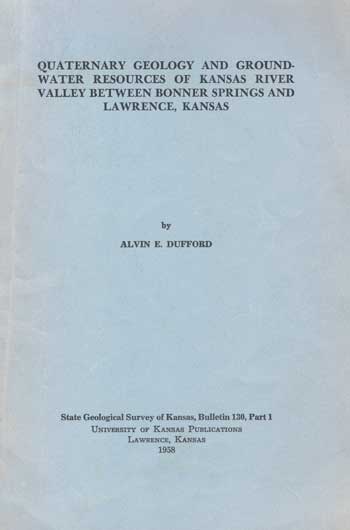Quaternary geology and ground-water resources of Kansas River valley between Bonner Springs and Lawrence, Kansas
By Alvin E. Dufford

Originally published in 1958 as Kansas Geological Survey Bulletin 130, part 1. This is, in general, the original text as published. The information has not been updated.
Abstract
This report describes the Quaternary geology and ground-water resources of a portion of Kansas River valley between Bonner Springs and Lawrence, Kansas. Unconsolidated Pleistocene sediments are widely distributed over Pennsylvanian bedrock in this part of northeastern Kansas. Glacial till and outwash of Kansan age are found as a discontinuous till sheet mantling the uplands and as an old dissected terrace bordering the larger valleys, but neither deposit is a good aquifer. Fine-grained fluvial deposits of Illinoian age have been destroyed almost completely along the Kansas River valley, but are preserved as isolated terrace remnants lying at intermediate positions along larger tributary valleys and yield a small amount of ground water. Wisconsinan and Recent stream-laid deposits constitute alluvial fills in the Kansas River valley and most tributary valleys, and average approximately 55 feet in thickness in the main valley. Kansas River valley alluvium is the only source of abundant ground-water supplies in this area. In 1953, more than 2,650,000 gallons per day of ground water was pumped from valley alluvium for domestic, stock, municipal, and industrial use, and adequate ground water is available for future industrial and irrigational expansion. The quality of the water is fair, and standard methods of water treatment easily remove carbonate hardness and excessive iron, the most objectionable features.
A map shows the distribution of Pleistocene deposits. Geologic cross sections, maps illustrating the configuration of the water table, a detailed contour map of the bedrock floor of a portion of the valley, and profiles showing the relationship of river terraces are included in the report. General effects of the 1951 flood are discussed, and a detailed map of flood deposits and channel changes has been compiled. Tables include records of typical wells and chemical analyses of water samples. Logs of test holes and water wells are given.
Kansas Geological Survey, Geology
Placed on web March 29, 2012; originally published April 15, 1958.
Comments to webadmin@kgs.ku.edu
The URL for this page is http://www.kgs.ku.edu/Publications/Bulletins/130_1/index.html